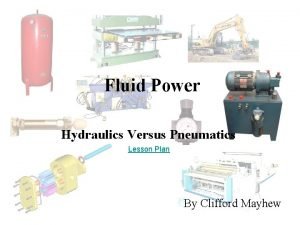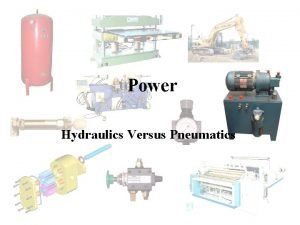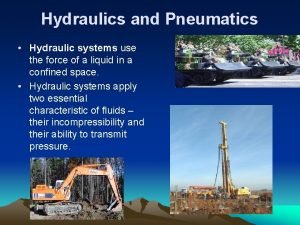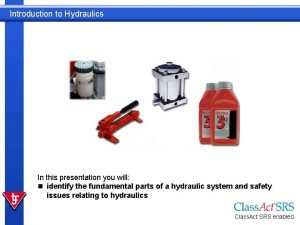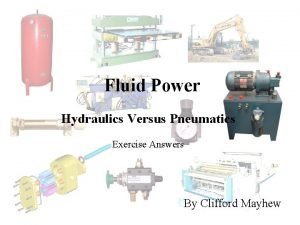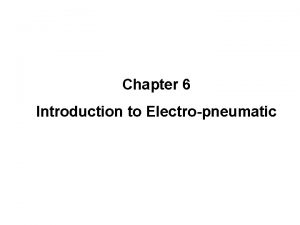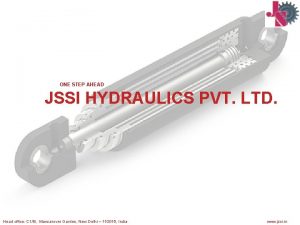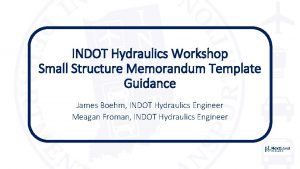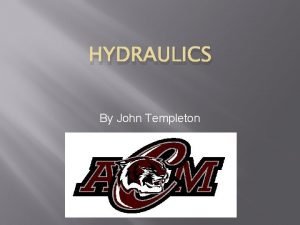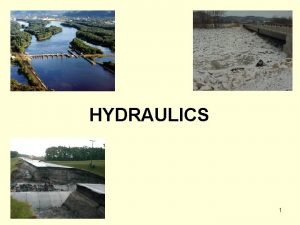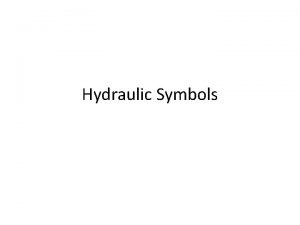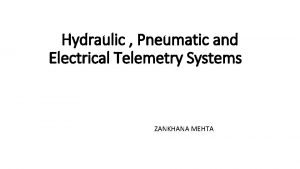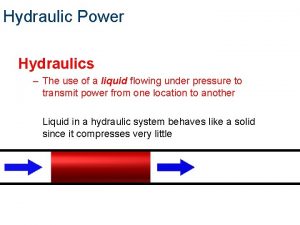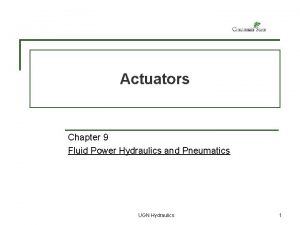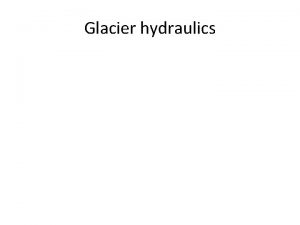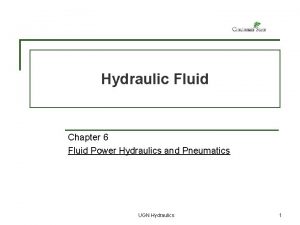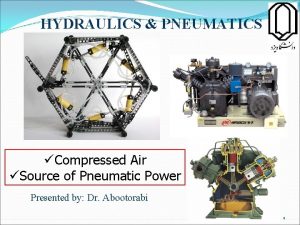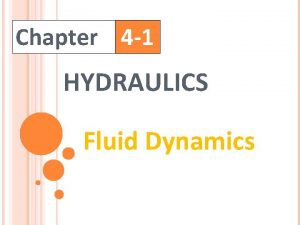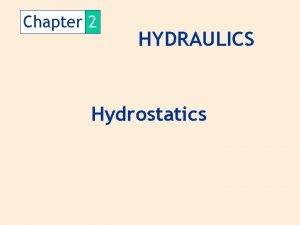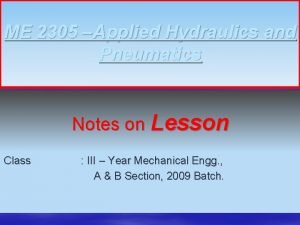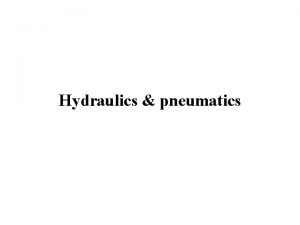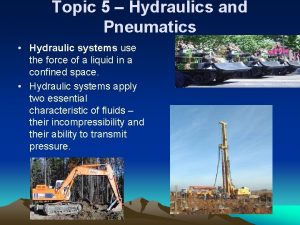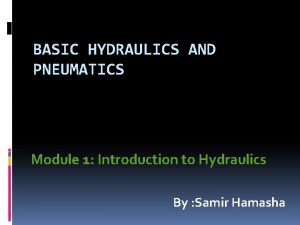Accumulators Chapter 11 Fluid Power Hydraulics and Pneumatics

























- Slides: 25

Accumulators Chapter 11 Fluid Power Hydraulics and Pneumatics UGN Hydraulics 1

Basic Functions of an Accumulator n Simple hydraulic systems cannot store energy q n Stopping the energy input stops system operation Accumulators absorb and store energy in a system q q Prevent system damage by absorbing energy from pressure surges Store energy by lifting a weight, compressing a spring, or compressing a gas UGN Hydraulics 2

Weight-Loaded Accumulators n n Large, vertically-mounted cylinder with heavy weight attached to end Typically used in central hydraulic systems powering heavy, stationary presses q n Seldom used today because of massive size and weight The only accumulator that can deliver entire fluid volume at nearconstant pressure q Disadvantage is high shock pressure UGN Hydraulics 3

Spring-Loaded Accumulators n n Uses one or more springs to store energy Rate of spring compression or extension is not the same over the entire length of spring q n n No constant rate of fluid intake or discharge Can be mounted in any position Difficult to adjust, not practical for systems with large fluid quantities UGN Hydraulics 4

Gas-Charged Accumulators n n n Uses compressed, inert gas for energy storage Most common type of accumulator Piston, bladder, or diaphragm type q q Separates gas from liquid to prevent gas entrainment Allows gas to be precharged to a specific pressure UGN Hydraulics 5

Caution n Pure oxygen should never be used in gas-charged accumulators UGN Hydraulics 6

Accumulator Design and Basic Construction n A piston accumulator has a cylindrical body containing a free-sliding piston Piston and piston seals divide the cylinder cavity into two chambers Fittings on either end allow the unit to be plumbed into a hydraulic system and a gas source UGN Hydraulics 7

Accumulator Design and Basic Construction n A bladder accumulator is a cylindrical metal shell with domed ends q q n One end has small hole for gas valve Other end has larger hole for bladder insertion A poppet valve prevents the precharge pressure in bladder from pushing part of the bladder into system line UGN Hydraulics 8

Accumulator Design and Basic Construction n A diaphragm accumulator is two metal hemispheres separated by diaphragm n Metal body sections are bolted together and form separate chambers q q One chamber is filled with a gas valve for precharging Other chamber is plumbed into the hydraulic system UGN Hydraulics 9

Operation of Gas-Charged Accumulators n Operation of the three types is very similar 1. Pressurized hydraulic fluid fills the liquid-side of the accumulator 2. It creates force against the surface of a piston, bladder, or diaphragm 3. That force moves these parts, reducing the volume of gas in the chamber 4. Gas is compressed, which stores energy 5. When the hydraulic fluid pressure drops, the gas is allowed to expand, forcing the piston, bladder, or diaphragm into the liquid side of the chamber and adding to the reduced fluid pressure UGN Hydraulics 10

Note n Accumulators begin to store fluid and energy when the system operating pressure exceeds the gas precharge pressure UGN Hydraulics 11

Nature of Compressed Gases n n n To understand the hydraulic system accumulator response to pressure, temperature, and volume changes you need a basic understanding of ideal gas laws An isothermal process completed without temperature change Adiabatic process is completed without heat gained from or lost to surrounding materials UGN Hydraulics 12

Functions of Accumulator Circuits n Storing energy q q System must be able to store energy to increase performance or efficiency Accumulator stores potential energy as it fills n n Raised weight, compressed the spring, or compressed gas Can store energy for extended periods UGN Hydraulics 13

Functions of Accumulator Circuits n Dampening pressure and flow variations q q Substantial pressure and flow variations can cause damage to the system and reduce efficiency Accumulators help reduce system problems n Careful sizing, precharging, and placement in circuit UGN Hydraulics 14

Functions of Accumulator Circuits n Maintaining system pressure q q q Maintain pressure for extended period of time when there is no actuator movement during a holding phase Accumulator absorbs the hydraulic fluid volume increase caused by expansion due to temperature increases Also resupplies fluid when the fluid volume decreases as temperature drops UGN Hydraulics 15

Functions of Accumulator Circuits n Supplementing pump outlet q q q Accumulator is filled during lowflow-need portion of operating cycle Stored fluid and fluid output of pumpis combined during the high-flow-need portion Combined fluid output provides a high flow rate needed to efficiently operate machines UGN Hydraulics 16

Selecting and Sizing Accumulators n Manufacturers provide detailed data for accumulator models q Provide suggested procedures to follow for selection and installation UGN Hydraulics 17

Rated Capacity and Pressure Ratings n Rated capacity based on the precharged gas volume when all liquid has been expelled q n Range from under 1 pint to over 200 gallons Pressure rating based on maximum safe operating pressure for the unit q q Varies from 2, 000 psi to over 10, 000 psi Precharge pressures should not exceed 50% of rated pressure UGN Hydraulics 18

Usable Operating Volume n Is the volume of hydraulic fluid the unit can supply in specific system application n Determined by maximum operating pressure, minimum operating pressure, and precharge pressure q q Affects amount of fluid stored in the unit and amount that can be discharged Recommended precharge pressure is 100 psi below the minimum operating pressure required to perform the task UGN Hydraulics 19

Caution n Hydraulic accumulators are pressurized containers that need to be handled with care n Only individuals with specific training should install or repair accumulators UGN Hydraulics 20

Setup and Maintenance of Accumulators n Mounting position q Best position for any accumulator is vertical with the hydraulic connection facing downward n q q Reduces collection of contaminants Weight-type must always be vertically positioned Other types may be vertical, horizontal, or inclined UGN Hydraulics 21

Setup and Maintenance of Accumulators n Precharging q q q Critical for proper accumulator operation Depends on the function of accumulator in hydraulic system Check gas precharge pressure on a regular basis to avoid pressure loss UGN Hydraulics 22

Caution n Follow procedures suggested by the equipment manufacturer carefully to ensure accuracy and personal safety n Only charge a gas-charged accumulator after the hydraulic system has been reduced to 0 psi UGN Hydraulics 23

Working Safely with Accumulators n Charged accumulator has ability to supply fluid even when system appears to be powered down n Prominently display signs to remind operators of the proper discharging procedure n Safety bleed valves are recommended to ensure the accumulator is discharged when the power is shut off UGN Hydraulics 24

Caution n n Always fill an accumulator with inert gas to avoid an explosion and other safety hazards Never exceed the manufacturer-recommended precharge pressure Use soapy water to check for exterior gas leaks Identify internal gas leaks by bubbles in reservoir Remove all gas pressure from the accumulator before removing it from the hydraulic system UGN Hydraulics 25
 Give the standard graphical symbols for frl unit
Give the standard graphical symbols for frl unit Hydraulics vs pneumatics
Hydraulics vs pneumatics Storehouse with fluid tanks
Storehouse with fluid tanks Hydraulic and pneumatics
Hydraulic and pneumatics Introduction to hydraulics and pneumatics
Introduction to hydraulics and pneumatics Hydraulics and pneumatics quiz
Hydraulics and pneumatics quiz Hydraulics & pneumatics
Hydraulics & pneumatics Microprocessor accumulator
Microprocessor accumulator Transcellular fluid
Transcellular fluid Movement of body fluids
Movement of body fluids Synovial membrane
Synovial membrane Fluid statics deals with fluid at rest
Fluid statics deals with fluid at rest Fluid statics deals with fluid at rest
Fluid statics deals with fluid at rest How does water go through your body
How does water go through your body Interstitial vs intracellular
Interstitial vs intracellular Timeline fluid mechanics
Timeline fluid mechanics Saag ascites formula
Saag ascites formula Triangle of power
Triangle of power Double acting push button symbol
Double acting push button symbol Jssi hydraulics pvt. ltd
Jssi hydraulics pvt. ltd Indot design memo
Indot design memo Hydraulics definition
Hydraulics definition Hydraulics definition
Hydraulics definition Unidirectional variable displacement pump symbol
Unidirectional variable displacement pump symbol Mehta hydraulics
Mehta hydraulics Hydraulics
Hydraulics
